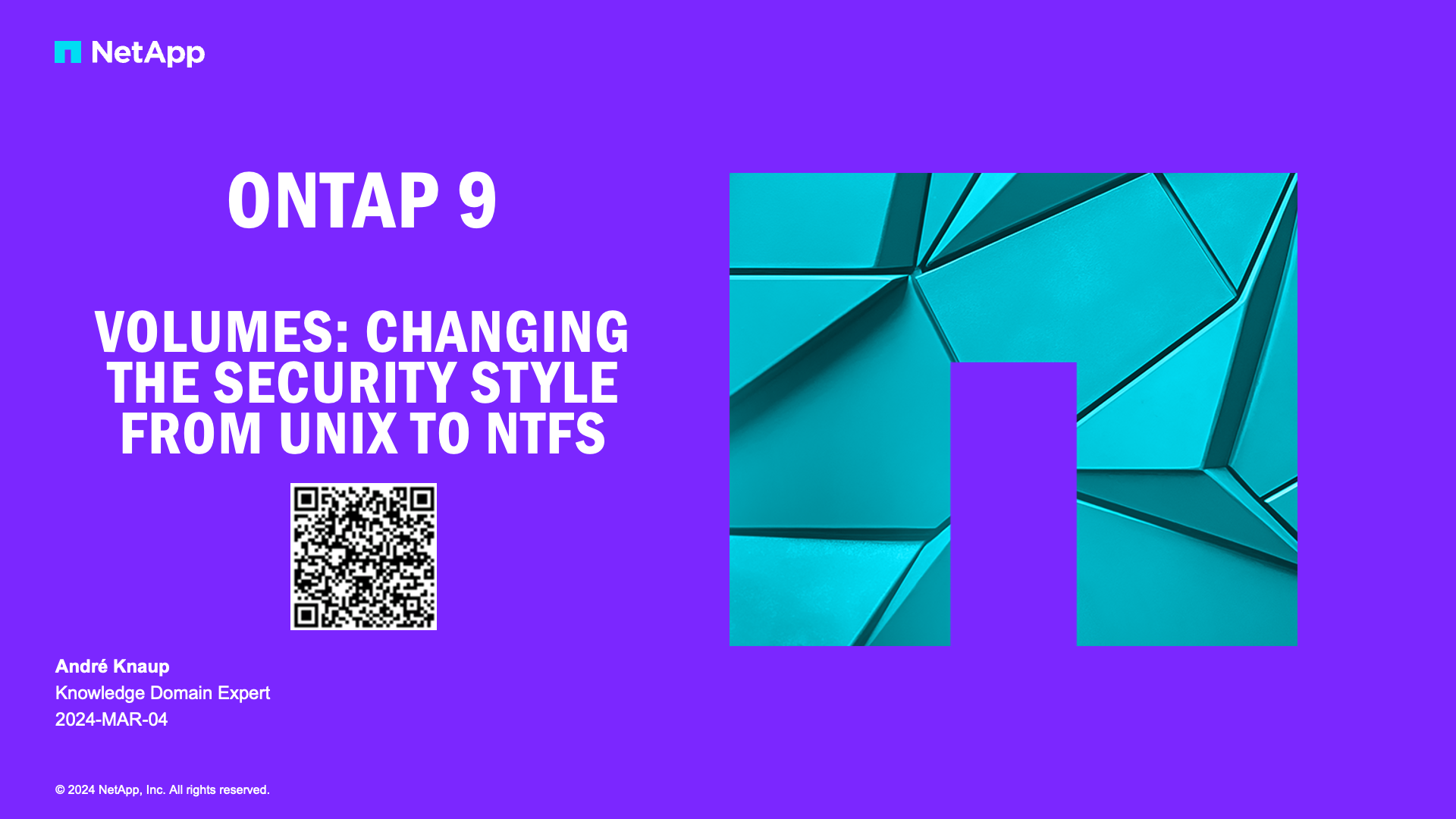ONTAP Discussions
- Home
- :
- ONTAP, AFF, and FAS
- :
- ONTAP Discussions
- :
- Re: Setting Snaplock min/max retention periods using Powershell
ONTAP Discussions
- Subscribe to RSS Feed
- Mark Topic as New
- Mark Topic as Read
- Float this Topic for Current User
- Bookmark
- Subscribe
- Mute
- Printer Friendly Page
Setting Snaplock min/max retention periods using Powershell
- Mark as New
- Bookmark
- Subscribe
- Mute
- Subscribe to RSS Feed
- Permalink
- Report Inappropriate Content
We are currently implenting a new instance of Snaplock on OnTap 9.1 and need to set the minimum and maxiumum retention periods on any new volumes that are created. From the CLI, you can use the vol snaplock modify command to set this, but we use WFA to provision all our volumes. So, we would ideally be able to use a Powershell command to set this.
Set-NcSnaplockRetentionTime seems like it would be the way to go, but there doesn't seem to be any options for setting the min/max. Does anyone know of any way to do this?
Solved! See The Solution
- Mark as New
- Bookmark
- Subscribe
- Mute
- Subscribe to RSS Feed
- Permalink
- Report Inappropriate Content
Hi Jim,
The API is "volume-set-snaplock-attrs" which relates to the "Set-NcSnaplockVolAttr" cmdlet. EG
Set-NcSnaplockVolAttr -Volume locked -MaximumRetentionPeriod "31 years" -VserverContext primary1
SYNTAX
Set-NcSnaplockVolAttr [-Volume] <String> [-MinimumRetentionPeriod <String>] [-DefaultRetentionPeriod <String>]
[-MaximumRetentionPeriod <String>] [-AutocommitPeriod <String>] [-VserverContext <String>] [-Controller
<NcController[]>] [-ZapiRetryCount <Int32>] [<CommonParameters>]
-MinimumRetentionPeriod <String>
Specifies the allowed minimum retention period for files to be committed to WORM state on the volume. Must be
specified as <number><suffix>. Valid suffixes are 'seconds', 'minutes', 'hours', 'days', and 'years'"
-MaximumRetentionPeriod <String>
Specifies the allowed minimum retention period for files to be committed to WORM state on the volume. Must be
specified as <number><suffix>. Valid suffixes are 'seconds', 'minutes', 'hours', 'days', and 'years'
The CLI process can be found here: https://library.netapp.com/ecm/ecm_download_file/ECMLP2507748
cluster1::> volume snaplock modify -vserver vs1 -volume vol1 -maximum-retention-period 10years cluster1::> volume snaplock modify -vserver vs1 -volume vol1 -minimum-retention-period 365days cluster1::> volume snaplock modify -vserver vs1 -volume vol1 -default-retention-period min
From a WFA perspective you'd need to create a command. For example:
#'------------------------------------------------------------------------------
Param(
[Parameter(Mandatory=$True, HelpMessage="The cluster name or IP Address")]
[String]$ClusterName,
[Parameter(Mandatory=$True, HelpMessage="The vserver name")]
[String]$VserverName,
[Parameter(Mandatory=$True, HelpMessage="The volume name")]
[String]$VolumeName,
[Parameter(Mandatory=$False, HelpMessage="The default retention period that will be applied to files when committed to WORM state if files has no explicit retention retention time set. Can be set to 'min', 'max', 'infinite' or a specific time in <number><suffix> format")]
[String]$DefaultRetentionPeriod,
[Parameter(Mandatory=$False, HelpMessage="The allowed minimum retention period for files to be committed to WORM state on the volume. Must be specified as <number><suffix>. Valid suffixes are 'seconds', 'minutes', 'hours', 'days', and 'years'")]
[String]$MinimumRetentionPeriod,
[Parameter(Mandatory=$False, HelpMessage="The allowed minimum retention period for files to be committed to WORM state on the volume. Must be specified as <number><suffix>. Valid suffixes are 'seconds', 'minutes', 'hours', 'days', and 'years'")]
[String]$MaximumRetentionPeriod,
[Parameter(Mandatory=$False, HelpMessage="The autocommit-period for the snaplock volume; any file unmodified for greater than this period will be committed to WORM state. Can be specified as <number><suffix>")]
[String]$AutocommitPeriod,
[Parameter(Mandatory=$False, HelpMessage="The autocommit-period for the snaplock volume; any file unmodified for greater than this period will be committed to WORM state. Can be specified as <number><suffix>")]
[Int]$ZapiRetryCount
)
#'------------------------------------------------------------------------------
#'Create the command for setting the volumes snaplock retention
#'------------------------------------------------------------------------------
[String]$command = "Set-NcSnaplockVolAttr -Volume $VolumeName "
If($MinimumRetentionPeriod){
[String]$command += "-MinimumRetentionPeriod $MinimumRetentionPeriod "
}
If($DefaultRetentionPeriod){
[String]$command += "-DefaultRetentionPeriod $DefaultRetentionPeriod "
}
If($MaximumRetentionPeriod){
[String]$command += "-MaximumRetentionPeriod $MaximumRetentionPeriod "
}
If($AutocommitPeriod){
[String]$command += "-AutocommitPeriod $AutocommitPeriod "
}
If($ZapiRetryCount){
[String]$command += "-ZapiRetryCount $ZapiRetryCount "
}
If($VserverName){
[String]$command += "-VserverContext $VserverName "
}
[String]$command += "-ErrorAction Stop"
#'------------------------------------------------------------------------------
#'Connect to the cluster
#'------------------------------------------------------------------------------
Connect-WFACluster $ClusterName
#'------------------------------------------------------------------------------
#'Invoke the command to set the snaplock retention for the volume.
#'------------------------------------------------------------------------------
Try{
Invoke-Expression -Command $command -ErrorAction Stop
Get-WFALogger -Info -Message "Executed Command`: $command"
Get-WFALogger -Info -Message "Set snaplock retention for volume ""$Volume"" on vserver ""$VserverName"""
}Catch{
Get-WFALogger -Error -Message $("Failed Executing Command`: $command. Error " + $_.Exception.Message)
Throw "Failed Setting Snaplock retention for volume ""$VolumeName"" on vserver ""$VserverName"""
}
#'------------------------------------------------------------------------------Note: I haven't tested this code. It's just an example to get you started.
/Matt
- Mark as New
- Bookmark
- Subscribe
- Mute
- Subscribe to RSS Feed
- Permalink
- Report Inappropriate Content
Hi Jim,
The API is "volume-set-snaplock-attrs" which relates to the "Set-NcSnaplockVolAttr" cmdlet. EG
Set-NcSnaplockVolAttr -Volume locked -MaximumRetentionPeriod "31 years" -VserverContext primary1
SYNTAX
Set-NcSnaplockVolAttr [-Volume] <String> [-MinimumRetentionPeriod <String>] [-DefaultRetentionPeriod <String>]
[-MaximumRetentionPeriod <String>] [-AutocommitPeriod <String>] [-VserverContext <String>] [-Controller
<NcController[]>] [-ZapiRetryCount <Int32>] [<CommonParameters>]
-MinimumRetentionPeriod <String>
Specifies the allowed minimum retention period for files to be committed to WORM state on the volume. Must be
specified as <number><suffix>. Valid suffixes are 'seconds', 'minutes', 'hours', 'days', and 'years'"
-MaximumRetentionPeriod <String>
Specifies the allowed minimum retention period for files to be committed to WORM state on the volume. Must be
specified as <number><suffix>. Valid suffixes are 'seconds', 'minutes', 'hours', 'days', and 'years'
The CLI process can be found here: https://library.netapp.com/ecm/ecm_download_file/ECMLP2507748
cluster1::> volume snaplock modify -vserver vs1 -volume vol1 -maximum-retention-period 10years cluster1::> volume snaplock modify -vserver vs1 -volume vol1 -minimum-retention-period 365days cluster1::> volume snaplock modify -vserver vs1 -volume vol1 -default-retention-period min
From a WFA perspective you'd need to create a command. For example:
#'------------------------------------------------------------------------------
Param(
[Parameter(Mandatory=$True, HelpMessage="The cluster name or IP Address")]
[String]$ClusterName,
[Parameter(Mandatory=$True, HelpMessage="The vserver name")]
[String]$VserverName,
[Parameter(Mandatory=$True, HelpMessage="The volume name")]
[String]$VolumeName,
[Parameter(Mandatory=$False, HelpMessage="The default retention period that will be applied to files when committed to WORM state if files has no explicit retention retention time set. Can be set to 'min', 'max', 'infinite' or a specific time in <number><suffix> format")]
[String]$DefaultRetentionPeriod,
[Parameter(Mandatory=$False, HelpMessage="The allowed minimum retention period for files to be committed to WORM state on the volume. Must be specified as <number><suffix>. Valid suffixes are 'seconds', 'minutes', 'hours', 'days', and 'years'")]
[String]$MinimumRetentionPeriod,
[Parameter(Mandatory=$False, HelpMessage="The allowed minimum retention period for files to be committed to WORM state on the volume. Must be specified as <number><suffix>. Valid suffixes are 'seconds', 'minutes', 'hours', 'days', and 'years'")]
[String]$MaximumRetentionPeriod,
[Parameter(Mandatory=$False, HelpMessage="The autocommit-period for the snaplock volume; any file unmodified for greater than this period will be committed to WORM state. Can be specified as <number><suffix>")]
[String]$AutocommitPeriod,
[Parameter(Mandatory=$False, HelpMessage="The autocommit-period for the snaplock volume; any file unmodified for greater than this period will be committed to WORM state. Can be specified as <number><suffix>")]
[Int]$ZapiRetryCount
)
#'------------------------------------------------------------------------------
#'Create the command for setting the volumes snaplock retention
#'------------------------------------------------------------------------------
[String]$command = "Set-NcSnaplockVolAttr -Volume $VolumeName "
If($MinimumRetentionPeriod){
[String]$command += "-MinimumRetentionPeriod $MinimumRetentionPeriod "
}
If($DefaultRetentionPeriod){
[String]$command += "-DefaultRetentionPeriod $DefaultRetentionPeriod "
}
If($MaximumRetentionPeriod){
[String]$command += "-MaximumRetentionPeriod $MaximumRetentionPeriod "
}
If($AutocommitPeriod){
[String]$command += "-AutocommitPeriod $AutocommitPeriod "
}
If($ZapiRetryCount){
[String]$command += "-ZapiRetryCount $ZapiRetryCount "
}
If($VserverName){
[String]$command += "-VserverContext $VserverName "
}
[String]$command += "-ErrorAction Stop"
#'------------------------------------------------------------------------------
#'Connect to the cluster
#'------------------------------------------------------------------------------
Connect-WFACluster $ClusterName
#'------------------------------------------------------------------------------
#'Invoke the command to set the snaplock retention for the volume.
#'------------------------------------------------------------------------------
Try{
Invoke-Expression -Command $command -ErrorAction Stop
Get-WFALogger -Info -Message "Executed Command`: $command"
Get-WFALogger -Info -Message "Set snaplock retention for volume ""$Volume"" on vserver ""$VserverName"""
}Catch{
Get-WFALogger -Error -Message $("Failed Executing Command`: $command. Error " + $_.Exception.Message)
Throw "Failed Setting Snaplock retention for volume ""$VolumeName"" on vserver ""$VserverName"""
}
#'------------------------------------------------------------------------------Note: I haven't tested this code. It's just an example to get you started.
/Matt
- Mark as New
- Bookmark
- Subscribe
- Mute
- Subscribe to RSS Feed
- Permalink
- Report Inappropriate Content
Thanks, Matt, that's exactly what I needed!
In case anyone else is looking at this, it looks like these commands are only available in the Powershell Toolkit v4.2 and later.
- Mark as New
- Bookmark
- Subscribe
- Mute
- Subscribe to RSS Feed
- Permalink
- Report Inappropriate Content
Thanks Jim,
From a WFA perspective you would need a minimum version of 4.0GA (latest 4.1GA release recommended) with the cDOT pack 1.3.2 to ensure the powershell toolkit includes the cmdlets:
You can check the PowerShell toolkit version include with WFA using the following commands on your WFA server:
PS C:\> cd 'C:\Program Files\NetApp\WFA\PoSH' PS C:\Program Files\NetApp\WFA\PoSH> .\profile.ps1 PS C:\Program Files\NetApp\WFA\PoSH> Get-NaToolkitVersion Major Minor Build Revision ----- ----- ----- -------- 4 2 0 0
/Matt


